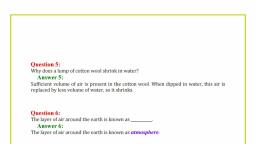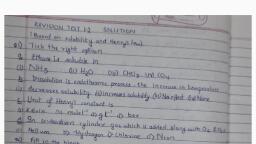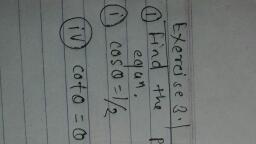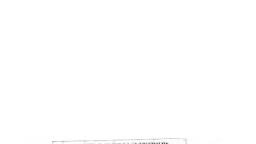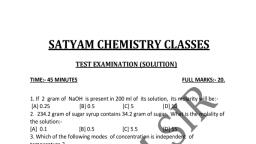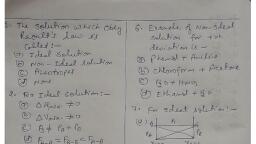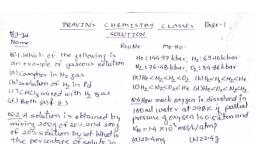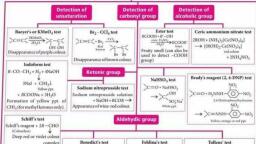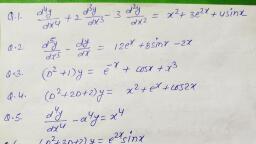Question 1 :
The mole fraction of solute in 10% (w/w) aqueous NaOH solution is:
Question 2 :
If we take 44g of${ CO }_{ 2 }$and 14g of${ N }_{ 2 }$ , what will be themole fraction of${ CO }_{ 2 }$in the mixture?
Question 3 :
Which of the following are homogenous in nature ?<br>(i) Ice<br>(ii) Wood<br>(iii) Soil<br>(iv) Air
Question 4 :
The sum of mole fractions of solute and solvent of a solution is equal to:
Question 5 :
The mole fraction of solute in a solution is 0.3 . The mole percent of solvent is:
Question 6 :
One kilogram of sea water sample contains $6\ mg$ of dissolved $O_{2}$. The concentration of $O_{2}$ in the sample in ppm is:
Question 8 :
$Y$ molal solution of a compound in benzene has mole fraction of solute equal to $0.2$. The value of ?
Question 9 :
The sum of mole fractions of solute and solvent of a solution is equal to:
Question 10 :
An ideal gaseous mixture of ethane and ethene occupy $28L$ as STP. The mixture required $128g$ ${O}_{2}$ combustion, ,mole fraction of ethene in the mixture is:
Question 11 :
In a glass we are having half filled water. Then we are continuously adding salt to the water and salt is getting dissolved into water. But a state occur when water is not able to dissolve salt. Then the solution is called as<b></b>
Question 12 :
The number of components in a binary solution are/is _______ .
Question 13 :
A certain public water supply contains $0.10$ ppb (part per billion) of chloroform ($CHCl_3$). How many molecules of $CHCl_3$ would be obtained in $0.478$mL drop of this water?<br>
Question 14 :
A gaseous mixture contains four gases $A,\ B,\ C$ and $D$. The mole fraction of $B$ is 0.5. the mole fraction of $A$ is:
Question 15 :
The vapour pressure of a solvent decreased by 10 mm of mercury when a non-volatile solute was added to the solvent. The mole fraction of the solute in the solution is 0.2. What should be the mole fraction of the solvent, if the decrease in the vapour pressure is to be 20 mm of mercury?
Question 16 :
Two successive reaction, $A\to B$ and $B\to C$ have yields of $90\%$ and $80\%$, respectively. What is the over all percentage yield for conversion of $A$ to $C$?
Question 17 :
$14.2$ g ${Na}_{2}S{O}_{4}$ is present in ${10}^{2}$ kg water. Its concentration in ppm is:
Question 19 :
The mole fraction of the solute in the $12$ molal solution of $Na_2CO_3$ is :<br/>
Question 20 :
For $1$ molar solution of $NaCl$ in water at $25^o$C and $1$-atm pressure show that:
Question 21 :
When $1$ mole of a substance is present in $1$ L of the solution, it is known as :
Question 22 :
If $M$ is molecular weight of solvent, $K_b$ is molal elevation constant, $T_b$ is its boiling point, $p^o$ is its vapour pressure at temperature $T$ and $p_s$, is vapour pressure of its solution having a non-volatile solute at $T\ K$, then:
Question 23 :
Which mass of solid residue is obtained from the thermal decomposition of $4.10$g of anhydrous calcium nitrate?
Question 25 :
Assertion: The percentage weight of a compound $A$ in a solution is given by,<br> $\; \; \; \; $ % $\displaystyle of \: A = \frac{Mass \:A}{Total \: mass \: of \: solution}\times 100$<br>$Because$
Reason: The mole fraction of a component $A$ is given by,<br> $\; \; \; \; $ $\displaystyle Mole \: fraction \: of \: A =\frac{Number of \: moles \: of \: A}{ Total \: number\: of \: moles \: of \: all \: components}$
Question 26 :
In a binary solution, mole fraction of solute is found to be 0.4. What could be the mole fraction of the solvent in the solution?
Question 27 :
A solution is prepared by adding 60 g of methyl alcohol to 120 g of water. Calculate the mole fraction of methanol and water.
Question 28 :
What is the quantity of water that should be added to $16$ g methanol to make the mole fraction of methanol as $0.25$?
Question 29 :
When $1.04 g$ of $BaCl_2$ is present in $105g$ of solution the concentration of solution is:
Question 30 :
A gaseous mixture contains $4.0$ gm of $H_{2}$ and $56.0$ gm of $N_{2}$. The mole fraction of $H_{2}$ in the mixture is:
Question 31 :
How much $BaCl_{2}$ would be needed to make $250\ ml$ of a solution having the same concentration of $Cl^{-}$ as one containing $3.78\, g\, NaCl$ per $100\ ml$? <br/>$\left(Ba=137\right)$<br/>
Question 32 :
$5.2$ moles of aqueous solution of 1 L of methyl alcohol, $CH_{3}OH$ is supplied. What is the mole fraction of methyl alcohol in the solution?
Question 33 :
The mole fraction of water in 20% (wt. / wt.) aqueous solution of $H_2O_2$ is:
Question 34 :
The density of a $10.0\%$ by mass of KCl solution in water 1.06 g/mL. Calculate molarity, molality and mole fraction of KCl in this solution respectively.<br/>
Question 35 :
$100mL$ of a water sample contains $0.81g$ of calcium bicarbonate and $0.73$ of magnesium bicarbonate. The hardness of this water sample expressed in terms of equivalents of $CaCO_3$ is:<br/>(molar mass of calcium bicarbonate is $162g$ $mol^{-1}$ and magnesium bicarbonate is $146gmol^{-1}$)
Question 36 :
One litre hard water contains $1$ mg $\displaystyle CaCl_{2}$ and $1$ mg $\displaystyle MgSO_{4}$. The hardness of water is:
Question 37 :
Mole fraction of ethanol $(C_2H_5OH)$ in ethanol-water system is $0.25$. Thus, it has :
Question 39 :
Oleum is considered as a solution of $SO_3$ in $H_2SO_4$. Which is obtained by passing $SO_3$ in solution of $H_2SO_4$.When 100 g sample of oleum is diluted with desired weight of $H_2O$ then the total mass of $H_2SO_4$.obtained after dilution is known as labelling of oleum. <br/><br/>For example , a oleum is diluted by 9 g of $H_2O$ which combined with all the free $SO_3$ to form $H_2SO_4$ as:<br/>$SO_3 +H_2O \rightarrow H_2SO_4$.<br/><br/>What is the % of free $SO_3$ in an oleum that is labelled as 104.5 % $H_2SO_4$?
Question 40 :
On adding solute to a solvent having vapour pressure $0.80 \,atm,$ vapour pressure reduces to $0.60 \,atm.$ Mole fraction of solute is:
Question 41 :
What per cent of the total aluminium in this ore is recoverable in the Bayer's process?
Question 42 :
Assertion: All homogeneous substances are pure.
Reason: Alloys are homogeneous mixtures of solids.
Question 43 :
The specific gravity of a given $ H_{2}SO_{4}$ solution is $1.76$ A quantity of $3.5 ml$ of the acid is diluted to $1.0 L$ and $25 ml$ of this diluted acid required $25.6 ml$ of $N/10 (f = 095) NaOH $ solution for complete neutralization. The percentage strength (by mass) of the original acid solution is
Question 44 :
What is the mole fraction of glucose in $10$% w/w glucose solution?
Question 45 :
A sample of $H_2O_2$ solution labelled as $28$ volume has density of $265$ g/L. Mark the correct option(s) representing concentration of same solution in other units.<br>
Question 46 :
The normality of a solution of a mixture containing $HCl$ and $ H_{2}SO_{4}$ is $N/5$. Twenty millilitres of this solution reacts with an excess of $ AgNO_{3}$ solution to give $0.287 g$ of silver chloride. The percentage of $HCl$ in the mixture by mass, is $(Ag = 108)$
Question 47 :
The concentration of fluoride, lead, nitrate and iron in a water sample from an underground lake was found to be $1000\ ppb, 40\ ppb, 100\ ppm$ and $0.2\ ppm$, respectively. This water is unsuitable for drinking due to high concentration of :
Question 48 :
Molality: It is defined as the number of moles of the solute present in 1 kg of the solvent. it is defined as 'm'.Molality(m) $=\dfrac {Number\, of \,moles\, of\, solute}{Number\, of \,kilo-grams\, of \,the solvent}$<br/>Let $W_A$ grams of the solute of molecular mass $m_A$ be present $W_B$ grams of the solvent, then, Molality(m)= $\dfrac {W_A}{m_A \times W_B}\times 1000$<br/>Relation between mole fraction and molality:<br/>$X_A =\dfrac {n}{N+n}$ and $X_B =\dfrac {N}{N+n}$<br/>$\dfrac {X_A}{X_B}=\dfrac {n}{N}= \dfrac {Moles \, of \, solute }{Moles \, of \, solvent}=\dfrac {W_A \times m_B}{W_B \times m_A}$<br/>$\dfrac {X_A \times 1000}{X_B \times m_B}=\dfrac {W_A \times 1000}{W_B \times m_A}=m $ or $ \dfrac {X_A \times 1000}{(1-X_A)m_B}=m$<br/><br/>What is the quantity of water that should be added to 16gm, methanol to make the mole fraction of the methanol as 0.25?<br/>
Question 49 :
<p>$RH_{2}$ (ionexchange resin) can replace $Ca^{2+}$ ions in hard water as: $RH_{2}+ Ca^{2+} \rightarrowRCa +2H^{+}$.</p><p>If $1\: L$ of hard water afterpassingthrough $RH_{2}$ has $pH = 3$, then hardness in parts per million of $Ca^{2+}$is:</p>
Question 50 :
Hydrogen gas adsorbed on surface of platinum is an example of solid in gas solution.
Question 51 :
A sample of drinking was found to be severely contaminated with chloroform, ${CHCl}_{3}$, supposed to be a carcinogen. The level of contamination was $15$ ppm (by mass). Express this in percent by mass.
Question 52 :
When $5.0$ gram of $BaCl_2$ is dissolved in water to have $10^6$ gram of solution. The concentration of a solution is:
Question 53 :
The hardness of water sample containing 0.002 mole of magnesium sulphate dissolved in a litre of water is expressed as:<br/>
Question 54 :
$4.6$ $cm^3$ of methyl alcohol is dissolved in $25.2$ g of water. Calculate mole fraction of methyl alcohol.
Question 56 :
The sum of mole fractions of solute and solvent of a solution is equal to :<br>
Question 57 :
Under what conditions will a pure sample of an ideal gas not only exhibit a pressure of $1$ atm, also a concentration of $1$ mole $litre^{-1}$?
Question 59 :
Assertion: A solution is a homogeneous mixture of two or more chemically non-reacting substances
Reason: Solution is prepared by the combination of two same phases of matter.
Question 61 :
What is the equivalent mass $ IO^-_4$ when it is converted into $I_2$ in acid medium ?
Question 62 :
A mixture has 18 g water and 414 g ethanol. The mole fraction of water in mixture is (assume ideal behaviour of the mixture) :
Question 63 :
$NO_2$ associates as $2NO_2\rightleftharpoons N_2O_4$.The experimental molecular weight of the reaction mixture is calculated from vapour density under certain conditions was 60. The mole fraction of dimer $N_2O_4$ is:
Question 64 :
$2.0\ g$ mixture of sodium carbonate and sodium bicarbonate on heating to constant weight gave $224\ mL$ of $CO_{2}$ at N.T.P.<br>The $\%$ weight of sodium bicarbonate in the mixture is:
Question 65 :
Mole fraction of the solute in a 1.00 molal aqueous solution is :
Question 66 :
A sample of oleum is labelled as $112\%$. In $200\ g$ of this sample, $18\ g$ water is added, The resulting solution will contain
Question 67 :
The compound $Na_2 CO_3 . x H_2O$ has $50  \%  H_2O$ by mass. The value of "x" is :
Question 68 :
$10$ L of hard water required $0.56$ g of lime $(CaO)$ for removing hardness. Hence, temporary hardness in ppm of $CaCO_3$ is:<br>
Question 69 :
$3$ mol of a mixture of $FeSO_4$ and $Fe_2(SO_4)_3$ required $100 mL$ of $2 M$ $KMnO_4$ solution in acidic medium. Hence, mole fraction of $FeSO_4$ in the mixture is:
Question 70 :
A candle is burnt in a beaker until it extinguishes itself. A sample of gaseous mixture in the beaker contains $6.08\times 10^{20}$ molecules of $N_2, 0.76\times 10^{20}$ molecules of $O_2$, and $0.50\times 10^{20}$ molecules of $CO_2$. The total pressure is 734 mm of Hg. The partial pressure of $O_2$ would be:
Question 71 :
In $200\ g$ of a sample of olem labelled as $109.0\% ,\ 12\ g$ water is added. The new labelling of the oleum sample is
Question 72 :
A sample of $H_{2}O_{2}$ solution labelled as $ 28\:$volume has density of $26.5\: g/L$. Mark the correct option(s) representing concentration of same solution in other units.
Question 73 :
$2.82\ g$ of glucose is dissolved in $30\ g$ of water. The mole fraction of glucose in the solution is:
Question 74 :
A sample of water has a hardness expressed as $77.5$ ppm $Ca^{2+}$. This sample is passed through an ion exchange column and $Ca^{2+}$ is replaced by $H^+$. Select correct statement(s).<br/>
Question 75 :
Washing soda $(Na_2CO_3.10H_2O)$ is widely used in softening of hard water. If $1$ L of hard water requires $0.0286$ g of washing soda, the hardness of $CaCO_3$ in ppm is :
Question 77 :
$12.8$ g of mixture of $MCl$ (volatile) and $KCl$ (non-volatile) on reaction with excess of aqueous $AgNO_3$ solution gave $28.7$ g white precipitate. $12.8$ g of same mixture on a heating gave a gas that on passing into $AgNO_3$ solution gave $14.35$ g of white precipitate. Hence :<br/>
Question 78 :
What is the percentage of carbon, by wt. in vitamin $C$ ?
Question 79 :
$ V_1 $ mL of NaOH of normality x and $ V_2  mL of Ba(OH)_2 $ of normality y are together sufficient to neutralize exactly, 100 mL of $ 0.1 N HCI. If V_ 1: V_2 =  1 : 4$ and if $x : y = 4 : 1, $what fraction of the acid is neutralised by$ Ba(OH)_2 $ ?
Question 80 :
$10$ L of hard water required $0.56$ g of lime (CaO) for removing hardness. Hence, the temporary hardness in ppm (part per million) of $CaCO_3$ is:
Question 81 :
Assuming that concentration of ${Ca}^{2+}$ ions in solution is in equal equivalence ratio to chloride ions, the hardness of water is :
Question 82 :
When $25g$ of ${Na}_{2}{SO}_{4}$ is dissolved in ${10}^{3}kg$ of solution, its concentration will be :
Question 83 :
Mole fraction of the solute in a 1.00 molal aqueous solution is:
Question 84 :
Hardness in water is expressed in terms of ppm of $CaCO_3$. If hardness is $200$ ppm $CaCO_3$, then in terms of molarity, it is:<br/>
Question 85 :
At $88^0 C$, benzene has a vapour pressure of 900 torr and toluene has a vapour pressure of 360 torr. What is the mole fraction of benzene in the mixture with toluene that will boil at $88^0 C$ at 1 atm pressure, benzene -toluene from an ideal solution?
Question 86 :
$RH_2$ (ion exchange resin) can replace $Ca^{2+}$ in hard water:       $RH_2 + Ca^{2+} \rightarrow RCa + 2H^+$<br/>$1\; L$ of hard water after passing through $RH_2$ has $pH= 2$. Hence, hardness in ppm of $Ca^{2+}$ is :<br/>
Question 87 :
Solution of $100ml$ water contains $0.73g$ of $Mg(HCO_3)_2$ and $0.81g$ of $Ca(HCO_3)_2$. Calculate the hardness in terms of ppm of $CaCO_3$.
Question 88 :
The hardness of water sample which contains $0.001$ mol $ MgSO_{4}$ per litre of water is:<br/>
Question 89 :
${10}^{24}$ molecules of solute are dissolved in ${10}^{25}$ molecules of solvent, the mole fraction of solute in solution is :
Question 90 :
A mixture of $a$ mol of $C_3H_8$ and $b$ mol of $C_2H_4$ was kept is a container of $V$ L which exerts a pressure of $4.93$ atm at temperature T. Mixture was burnt in presence of $O_2$ to convert $C_3H_8$ and $C_2H_4$ into $CO_2$ in the container at the same temperature. The pressure of gases after the reaction and attaining the thermal equilibrium with atmosphere at temperature T was found to be $11.08$ atm.<br/><br/>The mole fraction of $C_3H_8$ in the mixture is :<br/>
Question 91 :
What is the percentage of hydrogen by wt.in vitamin $C$ ?
Question 92 :
The hardness of water due to $HCO^{\circleddash}_3$ is $122$ ppm. Select the correct statement(s).<br/>
Question 93 :
$5.5\ mg$ of nitrogen gas dissolves in $180\ g$ of water at $273\ K$ and one atm pressure due to nitrogen gas. The mole fraction of nitrogen in $180\ g$ of water at $5\ atm$ nitrogen pressure is approximately :
Question 94 :
The concentration of $\displaystyle Ca\left ( HCO_{3} \right )_{2}$ in a sample of hard water is $486$ ppm. The density of water sample is $1.0$ g/ml. The molarity of the solution is :
Question 95 :
When $0.575 \times 10^{-2} kg$ of Glauber's salt ($Na_2SO_4\cdot 10 H_2O$) is dissolved in $3$ g water, we get $1$ $dm^3$ of a solution of density $1077.2 \:kg\: m^{-3}$. Calculate the molarity, molality and mole fraction of $Na_2SO_4$ in the solution:<br/>
Question 96 :
One litre of a sample of hard water contains $55.5$ mg of $CaCl_2$ and $4.75$ mg of $MgCl_2$. The total hardness in terms of ppm of $CaCO_3$ is :
Question 97 :
$500$ g of urea solution of mole fraction $0.2$ is diluted to $1500$ g. The mole fraction of solute in the diluted solution is:
Question 98 :
<blockquote>Amount in g of simple containing 80% NaOH required to prepare 60 litre of 0.5 M solution is :</blockquote>
Question 99 :
The mole fraction of methanol in $4.5$ molal aqueous solution is:
Question 100 :
When $200\ g$ of an oleum sample labelled as $109\%$ is mixed with $300\ g$ of another oleum sample labelled as $118\%$ the new labelling of resulting oleum sample becomes
Question 101 :
From the following data of $\Delta H$, of the following reactions,<br/>$C(s)+\dfrac{1}{2}O_2(g)\rightarrow CO(g)AH=-110$ kJ<br/>$C(s)+H_2O(g)\rightarrow CO(g)+H_2(g)\Delta H=132$ kJ<br/>What is the mole composition of the mixture of steam and oxygen on being passed over a coke at $1273$ K, keeping the temperature constant?<br/>
Question 102 :
The ppm strength of $CO_2(g)$ volume by volume (mL of $CO_2$ per $10^6$ mL of air) is:
Question 104 :
The expression relating mole fraction of solute $(\chi_2)$ and molarity (<b>M</b>) of the solution is (where <b>d</b> is the density of the solution in $g L^{-1}$ and $Mw_1$ and $Mw_2$ are the molar masses of solvent and solute, respectively) :
Question 105 :
The mole fraction of $NaCl$, in a solution containing 1 mole of $NaCl$ in 1000 g of water is:
Question 106 :
$1$ mole $N_{2}$ and $4$ mole $H_{2}$ are allowed to react in a vessel and after reaction $H_{2}O$ is added to the vessel. Aqueous solution required $1$ mole $HCl$. Mole fraction of $H_{2}$ in the gaseous mixture after the reaction is:
Question 107 :
The mole fraction of water in 98% (w/w) $H_2SO_4$ solution is :
Question 108 :
$30\: mL$ of $CH_{3}OH (d = 0.8\: g/cm^{3})$ is mixed with $60\: mL$ of $C_{2}H_{5}OH (d= 0.92\: g/cm^{3})$ at $25 ^\circ C$ to form a solution of density $0.88\: g/cm^{ 3}$. Select the correct option.
Question 109 :
To determine soluble (free) $SiO_2$ in a rock, an alkaline extraction was carried out, as a result of which there was found $1.52\%$ of $SiO_2$ in the extract and also $1.02\%$ of $Al_2O_3$. Considering that, apart from the free $SiO_2$, the extract also contained the $SiO_2$, that had passed into it from Kaolin $(2SiO_2, Al_2O_3)$, the percentage of $SiO_2$, in the rock being analysed is $(Si=28, Al=27)$
Question 110 :
The mole fraction of the solute in a $1$ molal aqueous solution is:
Question 111 :
What is the percentage of silica present in the ore, by weight?
Question 112 :
Calculate the mole fraction of glucose in an aqueous solution that contains 45 g of glucose in 45 g of water. Find out the weight of NaOH required to be disolved in 90 g of water in order to get a solution of the same mole fraction.



